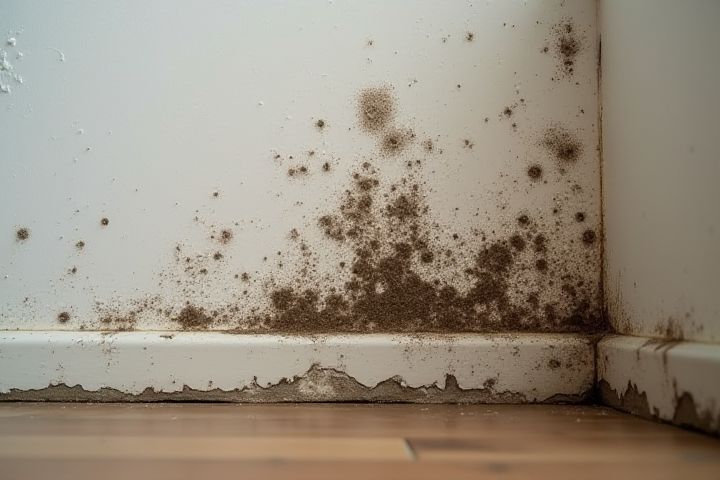
Mold thrives in environments with excess moisture, so if your house has mold, it likely indicates a humidity issue or water intrusion. Common sources of moisture include leaky roofs, plumbing leaks, or inadequately ventilated bathrooms and kitchens. Mold can also grow in hidden areas, such as behind walls or under flooring, making it crucial to address any water damage promptly. To effectively combat mold, you should maintain indoor humidity levels below 60%, ensure proper ventilation, and repair any leaks immediately. Regular inspections and proactive maintenance can significantly reduce the likelihood of future mold issues in your home.
Why Does My House Have Mold
Moisture buildup
Moisture buildup in your home creates an ideal environment for mold growth, thriving in humidity levels above 60%. Common sources of excess moisture include leaks from pipes, condensation on windows, and high indoor humidity from cooking or showering. Inadequate ventilation in areas like basements and bathrooms further exacerbates this issue, allowing mold spores to settle and proliferate. Regularly monitoring humidity levels and ensuring proper ventilation can significantly reduce the risk of mold infestation in your living spaces.
Poor ventilation
Poor ventilation in your house can significantly contribute to mold growth by allowing moisture to accumulate in enclosed or poorly circulated spaces. A lack of adequate airflow can trap humidity, creating an ideal environment for mold spores to thrive. Studies show that homes with high humidity levels, often above 60%, are at a greater risk for mold infestations. Ensuring proper ventilation in areas like bathrooms, kitchens, and basements can help maintain lower humidity levels and reduce the likelihood of mold development.
High humidity levels
High humidity levels often create an ideal environment for mold growth in your house. When indoor humidity exceeds 60%, moisture can accumulate on surfaces such as walls, wood, and ceilings, providing mold spores with the conditions they need to thrive. Sources of high humidity include inadequate ventilation, running appliances like dryers without proper exhaust, and leaks from plumbing or roofs. By controlling humidity through dehumidifiers, ventilation fans, and regular maintenance, you can significantly reduce the likelihood of mold presence in your home.
Leaky roofs or pipes
Mold growth in your house can often be traced back to leaky roofs and pipes, as these sources create damp environments ideal for mold spores to thrive. A compromised roof can allow rainwater intrusion, leading to moisture accumulation in ceilings and walls, while leaking pipes can saturate surrounding materials, providing a continuous source of water. It's essential to regularly inspect both your roof and plumbing systems for signs of damage or wear, as even small leaks can lead to significant mold issues over time. Maintaining a dry environment through proper repairs and ventilation is critical to eliminating the risk of mold and protecting your home's health.
Flooding or water damage
Mold growth in your house often results from flooding or water damage, as these conditions create a moist environment ideal for mold spores to thrive. When water infiltrates your home through leaks, broken pipes, or flooding, it saturates materials like wood, drywall, and carpets, providing a nutrient-rich substrate for mold. After water damage, it's crucial to address the source and remediate any excess moisture quickly, as mold can start to develop within 24 to 48 hours. Your health may be at risk, as mold exposure can lead to respiratory issues, allergies, and other health complications, making timely intervention essential.
Inadequate drainage
Inadequate drainage around your home can lead to water accumulation, creating a damp environment ideal for mold growth. When rainwater or groundwater is not effectively diverted away from your foundation, it seeps into crawl spaces or basements, raising humidity levels and promoting mold proliferation. According to the Environmental Protection Agency (EPA), mold can begin to grow in just 24 to 48 hours in such conditions. Regularly inspecting and maintaining gutters, downspouts, and landscaping can significantly reduce the risk of mold caused by poor drainage.
Condensation on surfaces
Condensation on surfaces occurs when warm, moist air comes into contact with cooler surfaces, creating an environment conducive to mold growth. This often happens in areas with poor ventilation, such as bathrooms, kitchens, or basements, where humidity levels can rise significantly. You might notice mold forming on walls, windows, or ceilings, as these surfaces are typical spots for condensation to accumulate. To prevent mold, consider improving ventilation and using dehumidifiers to keep indoor humidity levels below 60%.
Lack of sunlight exposure
Mold thrives in environments with high humidity and limited sunlight exposure, making dark areas of your home particularly susceptible to growth. Sunlight acts as a natural disinfectant, reducing moisture levels and inhibiting mold spores from flourishing. Rooms with few windows or those that are shaded for most of the day often experience dampness, which fosters ideal conditions for mold proliferation. You can prevent mold by ensuring good air circulation, using dehumidifiers, and increasing sunlight exposure in affected areas.
Poor insulation
Poor insulation in your home can create conditions that are conducive to mold growth. When insulation is inadequate, it allows warm, moist air from inside your living spaces to escape into walls and attics, leading to condensation that promotes mold proliferation. Areas like basements and crawl spaces, often poorly insulated, are particularly vulnerable to dampness, further exacerbating the mold issue. Ensuring proper insulation and ventilation can help maintain optimal humidity levels, reducing the risk of mold development in your residence.
Infrequent cleaning and maintenance
Infrequent cleaning and maintenance can create an ideal environment for mold growth in your house. Dust, dirt, and organic materials accumulate over time, providing nutrients for mold spores to thrive. Areas like bathrooms and kitchens, often neglected in routine cleaning, can become particularly susceptible due to moisture buildup. Regular cleaning and prompt attention to leaks or spills can significantly reduce mold proliferation and safeguard your living space.
